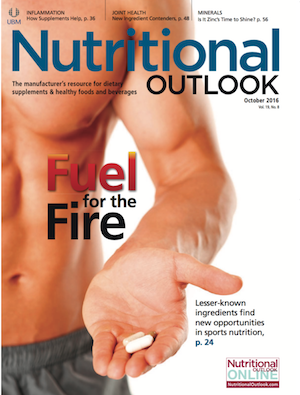Gut Check: Digestive-Health Market Update
The digestive-health market is thriving. Experts explain why probiotics and low-FODMAP diets are growing their slice of the pie.
Photo © iStockphoto.com/VikaValter

Digestive health is one of the most successful dietary supplement categories today. Whether it’s gluten avoidance or probiotic usage, discussions of gastrointestinal (GI) health aren’t just trending on talk shows and wellness blogs; they’re fueling an entire category of functional foods, beverages, and ingredients that promise smoother gastrointestinal sailing.
As Julian Mellentin, director, New Nutrition Business (London), wrote last year in another trade publication, “It’s often overlooked how much consumers’ interest in good digestive health powers many other trends.”[1] Product developers who do overlook interest in digestive health do so at their peril, for digestive health, Mellentin wrote, “is a benefit with wide appeal.”
Modern Tendencies
How wide of an appeal? Marissa Gilbert, health and wellness analyst, Mintel (Chicago), notes that two-thirds of adults have experienced some species of gastrointestinal issue, “indicating a strong consumer base for the digestive-health market,” she says. And a dive into her company’s Global New Products Database (GNPD) reveals that as many as 16% of worldwide functional claims made between 2013 and 2015 spoke to digestion. As far as the global market value of the category goes, market researcher Euromonitor International pegged it at an impressive $70 billion in 2015 alone.
Such robust interest won’t surprise any of those who know gastro grief up close and personally. For, says Melissa DeVincenzo, chief marketing officer, TrueSelf Foods (Waccabuc, NY), “The pain and discomfort that come with gastrointestinal discomfort can wreak havoc on consumers’ quality of life.” Making matters worse, she adds, “Triggers associated with gastrointestinal discomfort can be difficult to identify, and treatment options limited.”
Factors like everyday stress, the postmodern tilt toward highly processed, fiber-poor diets, and the incontrovertible fact that none of us is getting any younger all compound the problem. The result: digestive health will be a concern going forward. As Euromonitor’s 2015 “Digestive Remedies in the US” report stated, “These modern tendencies have significantly increased the frequency of acute digestive ailments, such as indigestion, bloating, nausea, and diarrhoea."
Digestive Health = Whole Health
Fortunately for the afflicted, digestive distress is now worthy of dialogue. Once not fit for polite company, gut health has become easier to discuss, and that deepening discussion has made consumers more comfortable as contributors. Notes Megan DeStefano, probiotics marketing, DuPont Nutrition & Health (Madison, WI), “Consumers have always been bothered with digestive issues. But this more-public discussion has removed the taboo associated with it. Now consumers are less reluctant to share information with others who have similar issues.”
They’re less reluctant to share information with their clinicians, too, and the entire medical community-not just GI specialists-are realizing, along with the rest of us, that without digestive health, whole-body health is out of reach. As DeStefano says, “We’re seeing mounting evidence that healthcare professionals and consumers alike understand that good gut health can have benefits beyond the belly.”
That’s evidence that Mike Bush, senior vice president, Ganeden Biotech (Cleveland), and executive board president of the International Probiotics Association (IPA; Los Angeles), knows well. “Maintaining a healthy gut is unbelievably important, as the digestive system is ground zero for many of the body’s vital functions,” he says. “We know the role the gut plays in breaking down nutrients, but there’s growing evidence of a link between gut health and the proper function of the immune system, reduction in inflammatory processes, mood regulation, and metabolic processes.”
Feed Me
The more consumers learn about this gut-body connection, the more they value products that optimize the functioning of both. Further, though digestive-health supplements have long been mainstays of the sector, smart money now gravitates toward functional foods and beverages as naturally promoting healthy digestion.
The logic is elementary: If we know that some foods and drinks exacerbate digestive distress, it follows that “a chief solution can largely be attained through dietary management,” Gilbert says. What’s more, the food-first strategy fits with how health-aware consumers care for themselves today. Says Bush, “The beauty of functional foods is that consumers are able to get the desired health benefits from foods and beverages that they already enjoy without taking another pill.”
STORY CONTINUES ON PAGE 2
Bugging Out
Among the first foods and beverages to develop a following for their digestive benefits were fermented yogurts and dairy beverages rife with probiotic bacteria-the OGs of gut-health ingredients. As Bush points out, “While health fads have come and gone, the probiotic category appears to have serious stamina.”
He’s not kidding. Mintel’s “Digestive Health - US - July 2015” report found probiotics and prebiotics accounted for 69.4% of the digestive-health market in natural supermarkets that year. And in a consumer survey that Bush’s own company recently conducted, 40%–54% of respondents said they’d be willing to pay more for a food or beverage containing good gut bugs, while a notable 70% of them expressed a preference for consuming those probiotics in foods or drinks rather than via supplements. No wonder Ganeden’s partners launched more than 60 new probiotic SKUs during March 2016’s Natural Products Expo West trade show, Bush says-“more than double last year.”
Yet if consumers are hungry-and thirsty-for probiotic products, that doesn’t mean they’ll shell out for options that promise more than they deliver. The upshot: ingredients with scientific track records stand the best chance of success. DeStefano notes that “strong clinical studies” validate the ability of her company’s probiotic strains Bifidobacterium lactis HN019, Lactobacillus acidophilus NCFM, and Lactobacillus paracaseiLPC-37 to support both digestive and immune health. Multiple studies also support the company’s strain combination of NCFM + Bifidobacterium lactis Bi-07, she continues, noting that the probiotic tag team “is being added to new digestive-health products all the time.”
Bush touts the research behind his company’s probiotic strain, too. GanedenBC30 (Bacillus coagulans GBI-30, 6086) not only has 20-plus peer-reviewed clinical studies backing it, he says, but “survives ten times more effectively than yogurt cultures.” That hardiness suits it for use in product environments that would prove too much for standard probiotic strains to tolerate-environments like Brad’s Crunchy Kale, Kale Chi and Broccoli Poppers snacks, and Little Duck Organics’ Tiny Gummies range of fruit and vegetable snacks, all of which contain the branded probiotic ingredient. “The launches,” Bush says, “demonstrate the endless opportunities for probiotics to expand into new functional-food categories, including children’s products and healthy snacks.”
Sara Cahill, consultant, client insights, IRI Worldwide (Chicago), believes that “in a society where people are looking to take charge of their digestive issues,” probiotic products “will only continue to see more traction in the marketplace as consumers gain more knowledge and try-and remain satisfied-with the benefits of ‘good’ bacteria.”
As it stands, however, there’s still plenty of space in the room for marketers. IRI’s own All Outlet panel data reveal that fewer than 13% of households currently purchase probiotics. That hints at what she calls “a huge opportunity for educating consumers on the benefits of these products.”
Filling the FODMAP Gap
If probiotic products ever realize their full potential, they’ll have both healthy consumers as well as the digestively distressed to thank. By contrast, foods designed to fit into a low-FODMAP diet rely on a much narrower slice of the public for their success.
FODMAP stands for “fermentable oligo-, di-, monosaccharides, and polyols,” and it emerged as the guiding principle behind an entire way of eating because evidence suggests that limiting consumption of these poorly absorbed carbohydrates may ease symptoms in those suffering from irritable bowel syndrome (IBS) and other functional gastrointestinal disorders (FGID). As TrueSelf Foods’ DeVincenzo notes, “Gastroenterologists, nutrition scientists, and dieticians have identified that symptoms of digestive discomfort associated with gastrointestinal discomfort are relieved when the intake of FODMAPs is restricted.”
Alas, the modern Western diet abounds in FODMAPs, including lactose, sorbitol, xylitol, mannitol, and other sugar alcohols; short-chain fructans found even in healthful foods like beans, nuts, whole grains, and vegetables; and the fructose and other non-glucose monosaccharides present in high-fructose corn syrup, honey, and fruits like watermelon and apples. With these carbs so ever-present, people trying to avoid them could be forgiven for losing hope.
But as the need for low-FODMAP foods has grown, product developers-many who live with that need themselves-are launching products to fill the gap. Dr. Miechelle O’Brien, a practicing gastroenterologist and founder of TrueSelf Foods, is a case in point. “Day in and out,” she recalls, “I would listen to my patients as they told me about the difficulties of managing the pain and discomfort associated with their gastrointestinal disorders. And the treatment options I could offer were so limited.” Their tales inspired her to try low-FODMAP living alongside them-an experience that, for her, “confirmed the research” while leaving the latter feeling “better within two to three weeks, allowing them to enjoy a higher quality of life.”
But given that implementing a low-FODMAP diet involves a multi-week routine of scrutinizing labels and constructing meal plans from a strict do/don’t ingredient list, the utility of simplifying, if nothing else, the snacking portion of that regimen occurred to O’Brien, and TrueSelf Foods was born. Set for launch this summer, the line will begin with snacks bars, with expansion to follow. The company’s attained low-FODMAP certification from the FODMAP Institute for its bars, DiVincenzo says, “meaning they’re compliant with a low-FODMAP diet,” and the inaugural flavors of banana cinnamon, blueberry, lemon poppy, and pumpkin spice should give consumers sensory pleasure as well as gastrointestinal peace.
O’Brien certainly thinks so. She believes that her company’s products “will bring greater convenience to those looking to implement a low-FODMAP diet, with certified products that consumers can purchase with confidence.” And when it comes to digestive health, confidence is just what they’re looking for.
Disclosures:
[1] Mellentin J, “Key Trends in Functional Foods & Beverages for 2016,” Nutraceuticals World, vol. 18, no. 9 (November 2015): 34-38. http://www.nutraceuticalsworld.com/issues/2015-11/view_features/key-trends-in-functional-foods-beverages-for-2016

Polyphenols: The next generation of prebiotics is ready for liftoff
April 21st 2025Explore the prebiotic health benefits of polyphenols and the positive impact they may have on digestive and immune health. Polyphenols, such as those found in European black elderberry, may be an ideal solution for manufacturers trying to break into the digestive health space.

.png&w=3840&q=75)

.png&w=3840&q=75)



.png&w=3840&q=75)



.png&w=3840&q=75)
























